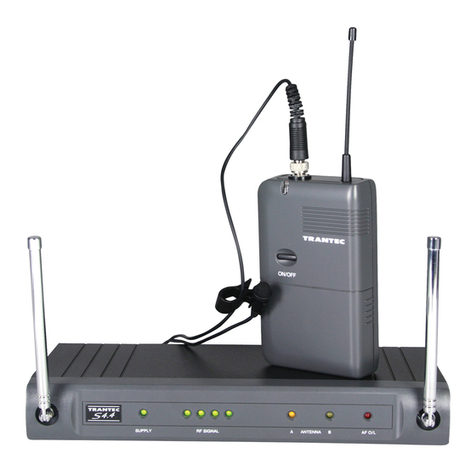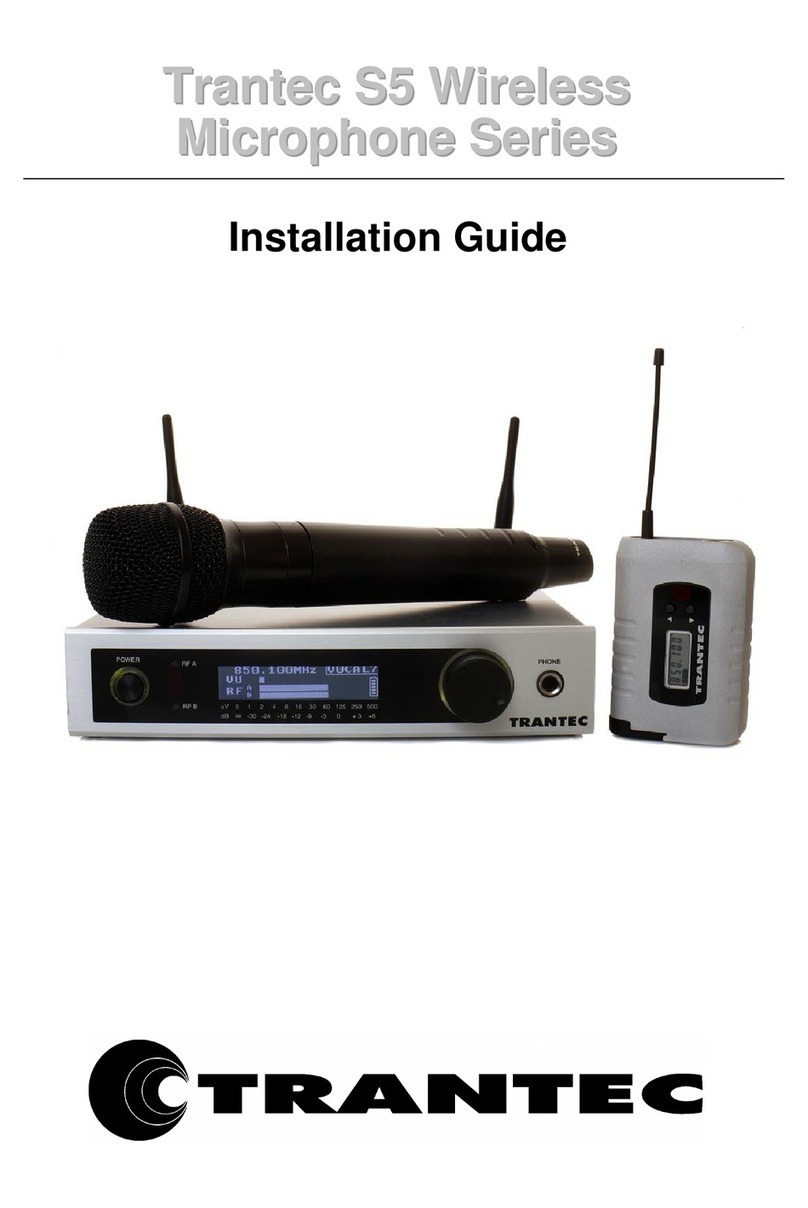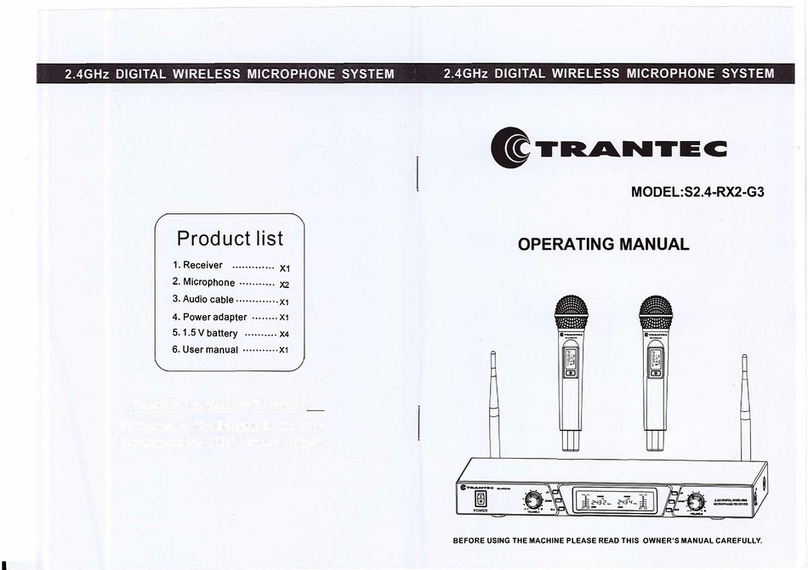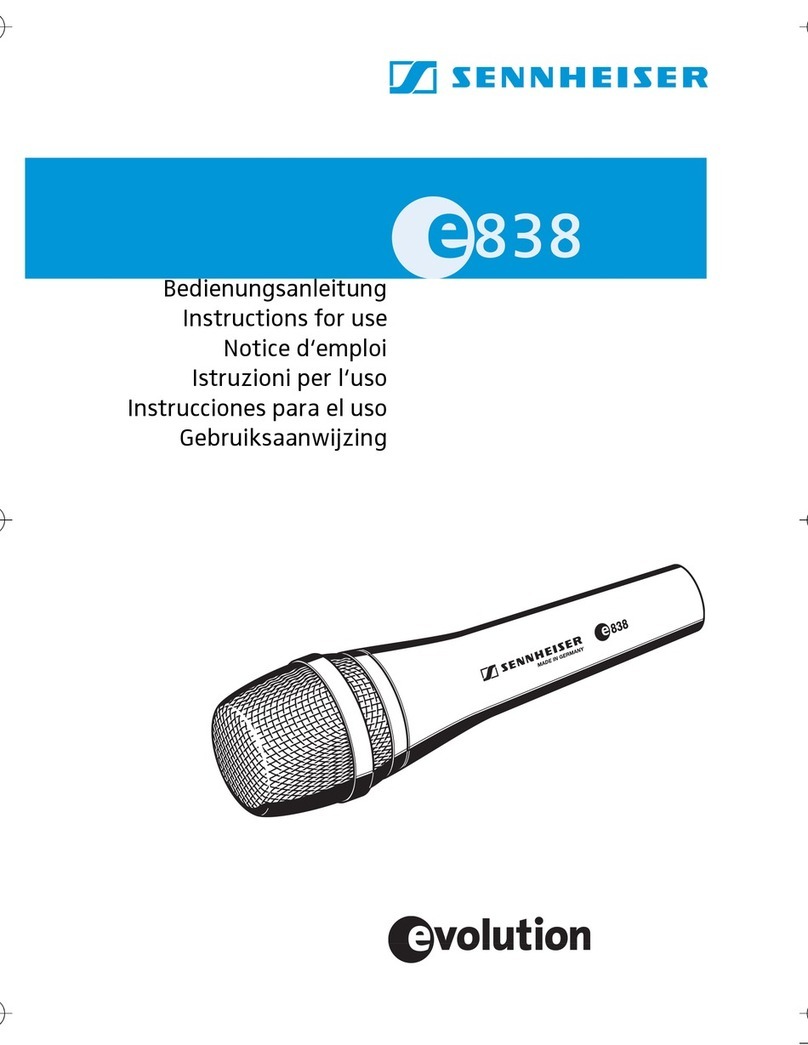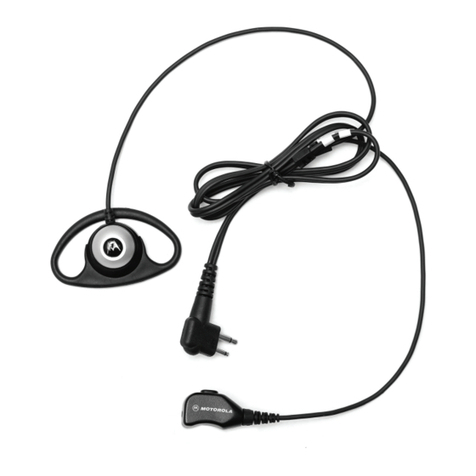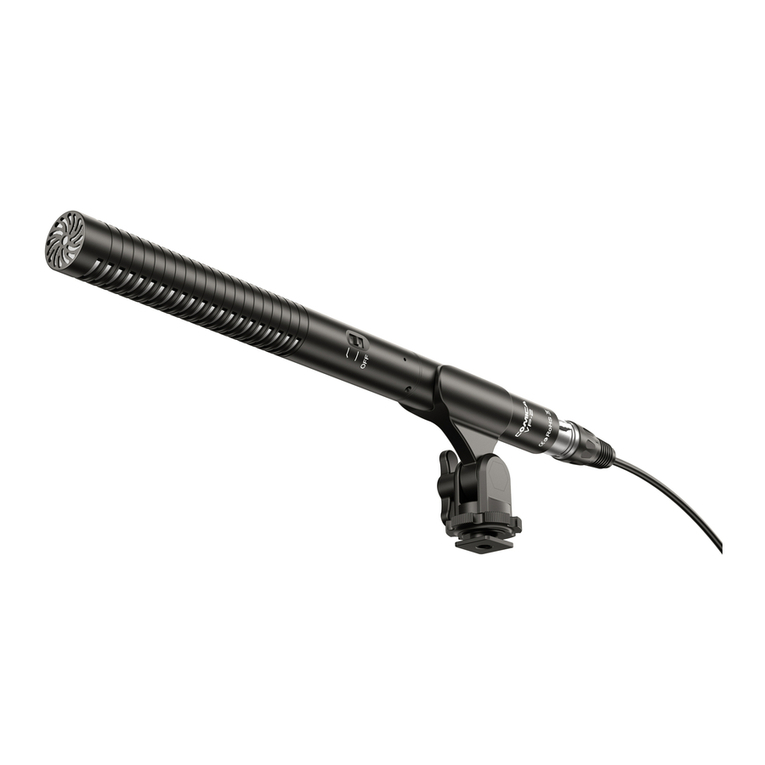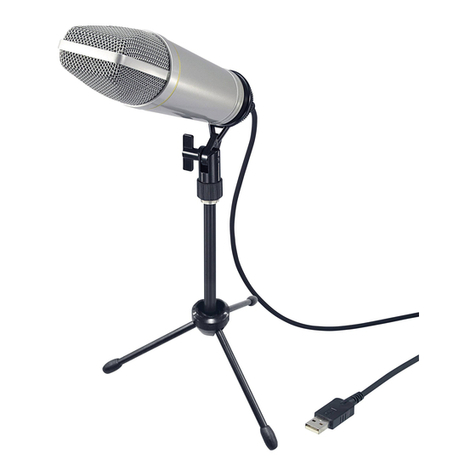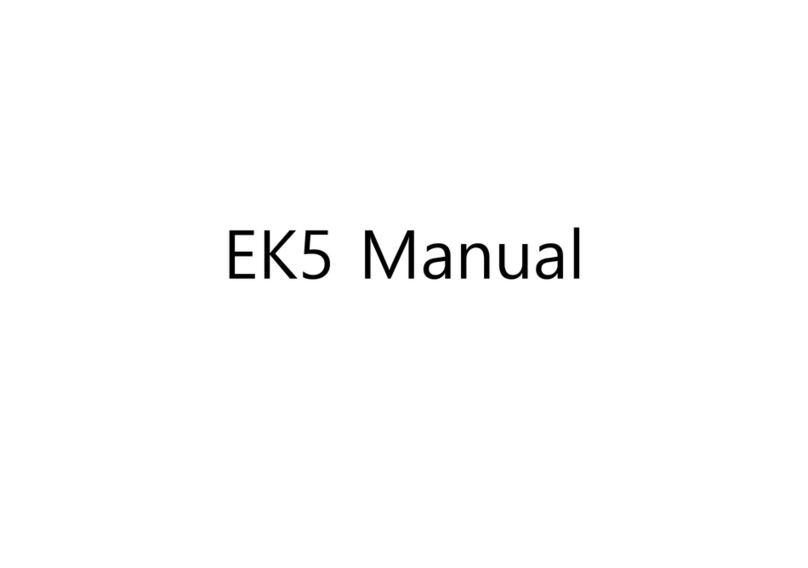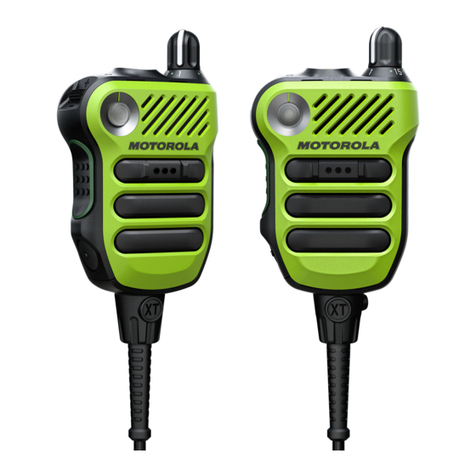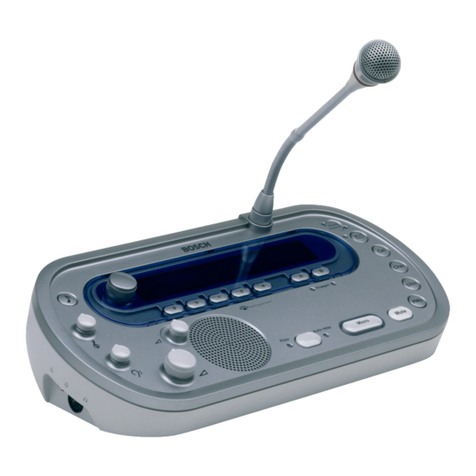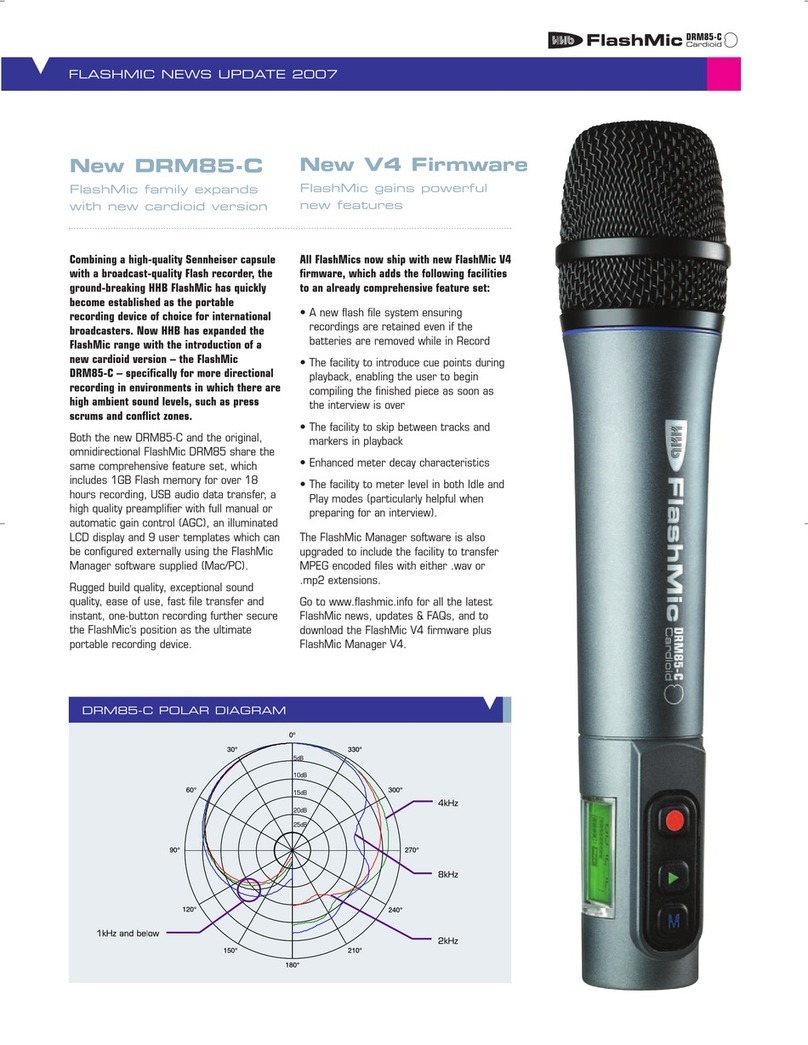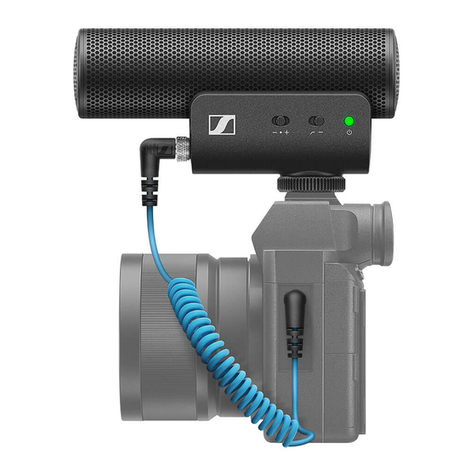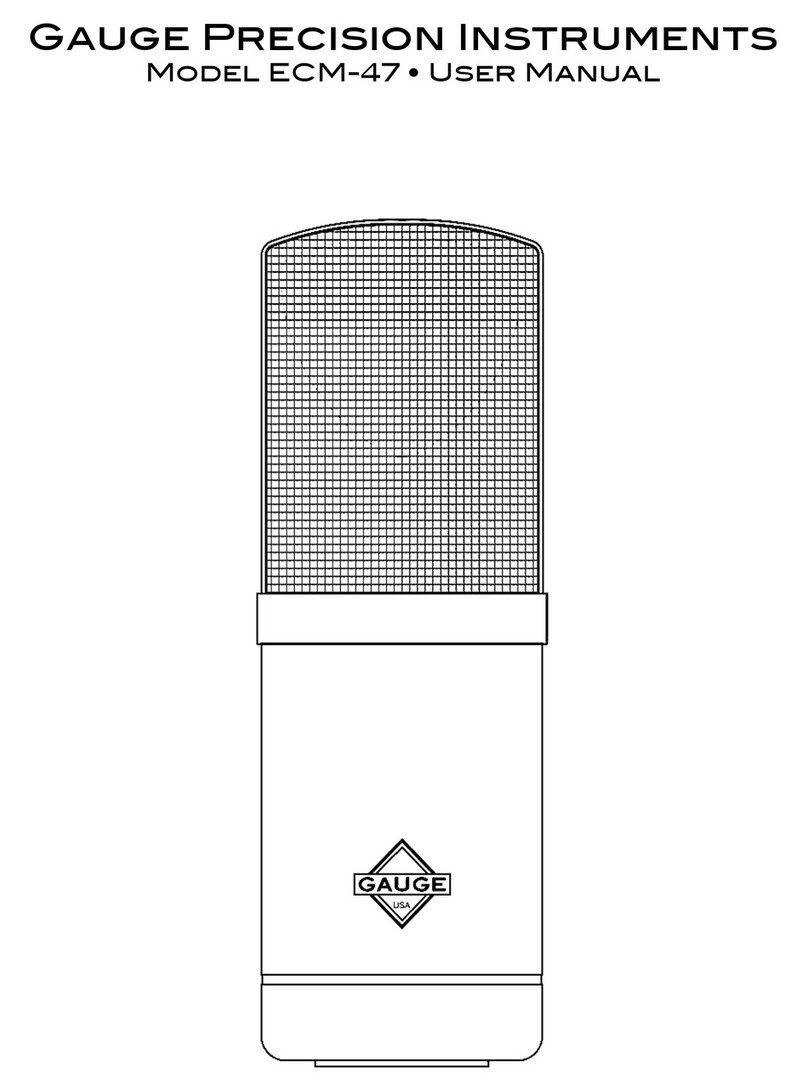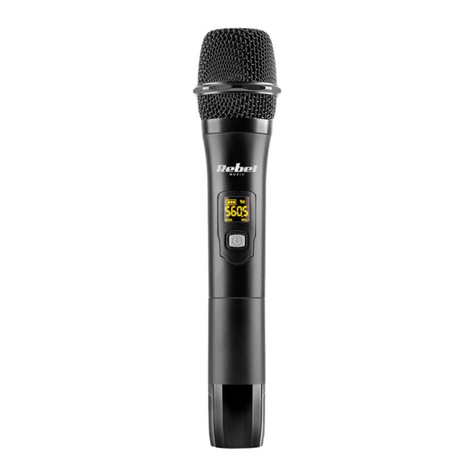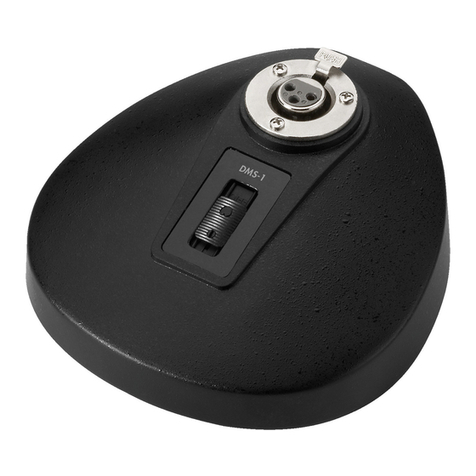Trantec S-D7200 User manual

OPERATING INSTRUCTIONS
TRANTEC S-D7200
DIGITAL WIRELESS MICROPHONE
Thank you for purchasing Trantec S-D7200 Digital Wireless Microphone.
Please carefully follow the instructions in this manual to ensure long, trouble-free use of your equipment.
TABLE OF CONTENTS
1. SAFETY PRECAUTIONS ............................. 2
2. GENERAL DESCRIPTION ........................... 2
3. FEATURES ................................................... 2
4. HANDLING PRECAUTIONS ........................ 3
5. NOMENCLATURE ........................................ 3
6. HOW TO INSERT BATTERIES .................... 4
7. DIMENSIONAL DIAGRAM ........................... 4
8. OPERATION ................................................. 5
9. OPERATIONAL HINTS ................................ 5
10. SETTING GROUP, CHANNEL, AND
ID NUMBERS ............................................. 5
10.1. What Is ID ? ........................................ 5
10.2. Frequency Table ................................. 6
11. GAIN SELECTOR SWITCH ........................ 7
12. TEST MODE ON/OFF SWITCH ................. 7
13. TROUBLESHOOTING ................................ 7
14. SPECIFICATIONS ...................................... 8
Accessories ................................................. 8

2
1. SAFETY PRECAUTIONS
• Beforeinstallationoruse,besuretocarefullyreadalltheinstructionsinthissectionforcorrectand safe
operation.
• Besuretofollowalltheprecautionaryinstructionsinthissection,whichcontainimportantwarningsand/or
cautionsregardingsafety.
• Afterreading,keepthismanualhandyforfuturereference.
Safety Symbol and Message Conventions
Safetysymbolsandmessagesdescribedbelowareusedinthismanualtopreventbodilyinjuryandproperty
damage which could result from mishandling. Before operating your product, read this manual rst and
understandthesafetysymbolsandmessagessoyouarethoroughlyawareofthepotentialsafetyhazards.
Indicatesapotentiallyhazardoussituationwhich,ifmishandled,could
resultindeathorseriouspersonalinjury.
WARNING
Indicatesapotentiallyhazardoussituationwhich,ifmishandled,could
resultinmoderateorminorpersonalinjury,and/orpropertydamage.
CAUTION
When the Unit is in Use
• Topreventtheelectromagneticwavefrombadlyinuencingmedicalequipment,makesuretoswitchoffthe
unit’spowerwhenplacingitincloseproximitytothemedicalequipment.
When the Unit is in Use
• Whentheunitisnotinusefor15daysormore, be sure to take the batteries out of the unit because battery
leakagemaycauseare,personalinjury,orcontaminationofenvironment.
• Makesuretoobservethefollowinghandlingprecautionssothatareorpersonalinjurydoesnotresultfrom
leakage or explosion of the battery.
· Donotshort,disassemble,heatnorputthebatteryintoare.
· Avoidusingbothnewandoldbatteriestogether.
· Donotsolderabatterydirectly.
· Besuretousethespeciedtypeofbatteries.
· Notecorrectpolarity(positiveandnegativeorientation)wheninsertingabatteryintheunit.
· Avoidlocationsexposedtothedirectsunlight,hightemperatureandhighhumiditywhenstoringbatteries.
2. GENERAL DESCRIPTION
TheS-D7200isaUHF-bandPLLsynthesizedwirelessmicrophonecapableoftransmittinghigh-qualitydigital
audiosignals.Abuilt-indynamictypemicrophoneunitfeaturesrobustnessandhigh-qualitysound.
3. FEATURES
• 32kHz/24-bithigh-qualitydigitalaudiosignalprocessingfreeswirelessmicrophonefromcompander-induced
soundqualitydegradationthatmayoccurinanalogsystems.
• DigitaltransmissionandIDsettingfunctionenhancecondentialityoftransmissioninformation.Besides,they
provideresistancetonoiseandradiointerference,andstabletransmission.
• Optionalreceiverallowsmonitoringofthewirelessmicrophone’sremainingbatterylevelandsettingdataby
meansofdigitaltransmission.
• Themaximuminputsoundpressurecanbesetintherangeof127dBSPLto142dBSPLbytheGainselector
switch,permittingadaptationtowiderangeofinputsoundpressure.
• Backlitoperationsectionhelpsyoumakesettingsindarklocations.
• Metalliccaseprovidesrobustnessandqualityfeeling.
• OperatesontwoAAbatteries.
• Employsabuilt-inantenna.

3
Wind screen
Lock ring
Battery case
Internal antenna Power indicator
Lights green while
power is on.
4. HANDLING PRECAUTIONS
• Neveropennorremovetheunitcasetomodifytheunit.ReferallservicingtoyournearestTOAdealer.
• Takecarenottodroptheunitontotheoornorbumpitagainstahardobjectastheunitcouldfail.
• Donotplacetheunitinlocationsofhightemperature(ex.inanill-ventilatedcarinsummer)orhighhumidity
astheunitcouldfail.
• Avoidusingtheunitinlocationsthatcanbesplashedwithperspirationorseawater,asthiscouldleadtounit
failures.
• Toclean,useadrycloth.Whentheunitgetsverydirty,wipelightlywithaclothdampedinadiluteneutral
cleanser,thenwipewithadrycloth.Neverusebenzine,thinner,orchemically-treatedcleaningtowel.
• Avoidusingamobiletelephoneneartheunitinuse.Noisecouldbepickedup.
5. NOMENCLATURE
(Seep.4.)
Operation section
Battery indicator
Power switch
Group selector
switch
Gain selector switch
ID selector switch
Test mode ON/OFF
button
Channel selector
switch
BATTERY
OFF ON
POWER
CHANNEL
GAIN
00
1
0
8
F
E
C
BA
D23
4
5
6
79
−15
−12 −9
−3
−6
1
2
3
4
5
6
7
8
9
ID
TEST
GROUP
1
0
8
F
E
C
BA
D23
4
5
6
79
(Seep.4.)
(Seep.5.)
(Seep.7.)
(Seep.5.)
(Seep.5.)
(Seep.7.)

4
Φ48
Φ30
37
260
Lock ring
BATTERY
Power
indicater
6. HOW TO INSERT BATTERIES
Note
Minimizethevolumeofthemixeroramplierconnectedto
thereceiverbeforeopeningorclosingthecase.
Step 1. Rotatethelockringinthearrowdirectionshownat
right, then pull the battery case down to open the
battery compartment.
Step 2. Turn off the power switch.
Step 3. Insert two AA batteries noting correct polarity.
Step 4. Replacethebatterycase,andlockthelockring.
The operation section is backlit while the battery case is
open,anditslightgoesoutwhenclosed.
[Recommended time of battery replacement]
Thebatteryindicatorlightsgreenwhenthebatteryisfullycharged,
and turns into orange followed by red as the battery becomes
weaker. Subsequently, the battery indicator starts ashing red,
thensignaltransmissionwillbestoppedsoon.Whentheindicator
lightsred,replacethebatterieswithnewones.
The power indicator also ashes when the battery indicator is
ashingred.
Rough estimate of operating time on alkaline battery use
Batteryindicatorstatus Remainingbatterylife
Litgreen 2.5 – 5.5 hrs
Litorange 1 – 2.5 hrs
Litred 15min–1hr(Batteriesmustbereplaced.)
Flashingred 0−15min(Batterylifeisabouttoend.)
Notes
• Operatingtimevariesdependingontheconditionofusesuch
as ambient temperature.
• Theindicatorashesgreenifthemicrophoneissettoaninvalid
group/channelforwhichnousablefrequencyisassigned.
(Seep.5.)
• Theindicatorashesorangewhenintestmode.(Seep.7.)
7. DIMENSIONAL DIAGRAM
Unit : mm

5
8. OPERATION
Step 1. Conrmthatthewirelessmicrophoneandthewirelessreceiverareidenticalingroup,channel,andID
numbers.
Step 2. Turn on the Power switch.
Then,conrmthebatteryindicatorlightsgreenororange.
Step 3. Turn off the power switch after use.
9. OPERATIONAL HINTS
• Whenusingtwoormorewirelessmicrophones,keepthematleast50cmawayfromeachothertoavoid
malfunctions or noise.
• Keepthewirelessmicrophoneatleast3mawayfromthereceivingantenna.Usingthewirelessmicrophone
incloseproximitytotheantennacouldresultinmalfunctionsornoise.
Itisrecommendedthatthewirelessreceiver’sbuilt-inantennaattenuatorbesetforappropriateattenuation
levelwhenitisunavoidabletousethemicrophoneclosertotheantenna.
Note: Thisdistancediffersdependingontheinstallationlocationoftheantennaandthelengthofthewired
coaxial cable.
10. SETTING GROUP, CHANNEL, AND ID NUMBERS
Step 1. Openthebatterycase,andturnoffthepowerswitch.
Note
The transmitting frequency and ID remain unchanged
evenifthenumbersettingsofgroup,channel,andIDare
performedwiththepowerswitchedon.
Step 2. Set the Group selector switch pointer to the desired
groupnumberwiththesuppliedscrewdriver.
Step 3. Likewise,setthechannelandIDselectorswitchestothe
desirednumbers.
Step 4. Turnonthepowerswitch,andreplacethebatterycase.
Notes
• You can use wireless microphones belonging to one of the
following8grouppairssimultaneously:Group0and1,……,8
and9,AandB,…..,EandF.
• Makesurethatthewirelessmicrophoneisidenticaltothewirelessreceiveringroup,channel,andIDnumbers.
Ifdifferent,thereceiverdoesnotreceivethemicrophonesignal.
10.1. What Is ID ?
TheS-D7000DigitalwirelesssystemrequiresID(IdenticationData)tobedeterminedinadvancebetweenthe
wirelessmicrophoneandreceiverwhichcommunicatewitheachother.Thereceiverperformsdigitalreceiving
processing to output audio signals when the ID contained in the digital signals received from the wireless
microphoneisthesameasthereceiver’sID.Evenifthereceiverreceivesdisturbingsignalsexistinginthe
neighborhood,itdoesnotperformdigitalreceivingprocessingunlessbothmicrophone’sandreceiver’sIDsare
identical,preventingaudiosignalsfrombeingoutput.
The S-D7000serieswirelessmicrophone andwireless receiverare equippedwith 10 ID numbers from “0”
through“9,”whichareswitchabledependingonthesituation.ProperlysettingIDsvalidatescondentialityof
information.
CHANNEL
0
01F
E
C
BA
D23
4
5
6
1
2
3
4
5
6
7
7
8
8
9
9
ID
GROUP
01F
E
C
BA
D23
4
5
6
7
8
9

6
10.2. Frequency Table
Channel Group
0 1 234567
0606.250 606.750 606.375 606.875 606.500 607.000 606.625 606.125
16 07. 25 0 6 07.7 5 0 6 07. 3 75 6 07. 8 75 6 07. 5 0 0 608.000 6 0 7.6 2 5 6 07.125
2608.250 608.750 608.375 608.875 608.500 609.000 608.625 608.125
3609.250 609.750 609.375 609.875 609.500 610.000 609.625 609.125
4610.250 610.750 610.375 610.875 610.500 611.000 610.625 610.125
5611. 250 611.750 611.375 611.875 611.5 0 0 612.000 611.625 611.125
6612.250 612.750 612.375 612.875 612.500 613.000 612.625 612.125
7613.250 613.750 613.375 613.875 613.500 614.000 613.625 613.125
8614.250 614.750 614.375 614.875 614.500 615.000 614.625 614.125
9615.250 615.750 615.375 615.875 615.500 616.000 615.625 615.125
A616.250 616.750 616.375 616.875 616.500 617.000 616.625 616.125
B617. 2 5 0 617.7 5 0 6 17. 3 75 617. 8 75 617. 50 0 618.000 617. 6 25 617.125
C618.250 618.750 618.375 618.875 618.500 619.000 618.625 618.125
D619.250 619.750 619.375 619.875 619.500 620.000 619.625 619.125
E620.250 620.750 620.375 620.875 620.500 621.000 620.625 620.125
F621.250 621.750 621.375 621.875 621.500 622.000 621.625 621.125
Channel Group
89ABC D EF
0622.250 622.750 622.375 622.875 622.500 623.000 622.625 622.125
1623.250 623.750 623.375 623.875 623.500 624.000 623.625 623.125
2624.250 624.750 624.375 624.875 624.500 625.000 624.625 624.125
3625.250 625.750 625.375 625.875 625.500 626.000 625.625 625.125
4 626.250 626.750 626.375 626.875 626.500 627.000 626.625 626.125
56 27. 2 5 0 6 27.7 5 0 627. 3 75 6 2 7.8 75 6 27. 5 0 0 628.000 627.625 62 7.125
6628.250 628.750 628.375 628.875 628.500 629.000 628.625 628.125
7629.250 629.750 629.375 629.875 629.500 630.000 629.625 629.125
8630.250 630.750 630.375 630.875 630.500 631.000 630.625 6 30.125
9631.250 631.750 631.375 631.875 631.500 632.000 631.625 6 31.125
A632.250 632.750 632.375 632.875 632.500 633.000 632.625 632.125
B633.250 633.750 633.375 633.875 633.500 634.000 633.625 633.125
C634.250 634.750 634.375 634.875 634.500 635.000 634.625 6 34.125
D635.250 635.750 635.375 635.875 635.500 636.000 635.625 635.125
E636.250 636.750 636.375 636.875 636.500 637.000 636.625 636.125
F637.250 6 3 7.7 5 0 637.375 6 3 7. 875 6 3 7.5 0 0 638.000 6 37. 6 25 6 3 7.12 5
[How to read the frequency table]
Upto16frequenciescanbeusedforeachgroupfrom"0"to"F."
Inaddition,eachpairofgroups"0"and"1,""2"and"3,""4"and"5,""6"and"7,""8"and"9,""A"and"B,""C"and
"D,"and"E"and"F"canbeused,enablingupto32frequenciestobeusedsimultaneously.
Note: TheGroupisfactory-presetto"0,"thechannelto"0,"andtheIDto"0."

7
11. GAIN SELECTOR SWITCH
Gaincanbechangedin6steps(0,−3,−6,−9,−12,and−15dB).
TheGainselectorswitchsetsthemicrophonesensitivitymaximumat“0
dB”positionandminimumat“−15dB”position.
Ifaloudvoicedistortstheoutputsound,decreasethesensitivitybysetting
theswitchtothe“−3dB”positionorlesswiththesuppliedscrewdriver.
Note: TheInputsensitivitysettingswitchisfactory-presetto"0dB."
12. TEST MODE ON/OFF SWITCH
• HoldingdowntheTestmodeON/OFFswitchfor1secondormorewith
thesuppliedscrewdrivercausesthetestsignaltobetransmitted.(This
condition is referred to as the Test mode.) Press this switch again to
returntotheusualcondition.
Note: Donotpresstheswitchtoostronglywithasharp-pointedobject,
as this may cause unit failure.
• Oncethepoweristurnedoff,thetestmodewillbereleasedthenexttimethepoweristurnedon.
• Whileintestmode,thereceiverdoesnotoutputaudiosignalsevenifitreceivestheradiosignalsfromthe
wireless microphone.
• For the test signal operation, refer to the S-D7000 Digital wireless system’s Setting software instruction
manualsuppliedwiththeS-D7802Digitalwirelessreceiver.
13. TROUBLESHOOTING
Symptom Point to check Remedy
Thebatteryindicatornot
lightevenifthepowerswitch
turnedon.
Batterypolaritynotcorrect. Reinsertbatteriescorrectly.
Batterydischarged. Replacethebatterieswithnewones.
When the power switch
turnedon,thebattery
indicatorashesred.
Batterydischarged. Replacethebatterieswithnewones.
When the power switch
turnedon,thebattery
indicatorashesgreen.
Group or channel set to the
onenotlistedinthefrequency
table.
Reset the group or channel according to
the“Frequencytable.”
Receiver’sreceivingantenna
indicatornotlightevenwhen
thepowerswitchturnedon.
(Nosignalreceived.)
Group,channel,andIDsetfor
the wireless microphone not
identical to those for wireless
receiver.
Reset the Group, channel, and ID for the
wireless microphone to the same ones for
wirelessreceiver.
Interferes with other wireless
microphonebeingused
simultaneously.
Group and channel not set
according to the “Frequency
table”(p.12).
Check the “Frequency table” (p.12), then
resetgroup andchannelaccordingtothe
table.
Two wireless microphones set
to the same ID number.
SetthedifferentIDnumber.
Distance between the wireless
microphones too close.
Keepthewirelessmicrophonesatleast50
cm away from each other.
Wireless microphone being
usedtooclosetothereceiving
antenna.
Keepthewirelessmicrophoneatleast3m
awayfromthereceivingantenna.
Thereceivedaudiosignals
distortedoraudioleveltoo
low.
Gain selector switch not set
correctly.
SettheGainselectorswitchappropriately
while monitoring receiver’s audio output
levelmeter.
GAIN
0
−15
−12
−3
−6
−9
TEST

8
14. SPECIFICATIONS
MicrophoneElement Unidirectionalmoving-coildynamictype
FrequencyRange 606–638MHz
ModulationSystem PLLsynthesized
RFCarrierPower Lessthan50mW(Factorypreset:10mWERP)
Transmission Distance 100mormore(openarea)
MaximumInputSoundPressureLevel 142dBSPL(atgainof−15dB)
AudioFrequencyResponse 50Hz–15kHz
Antenna Built-intype(Internalhelicalantenna)
ModulationType π/4shiftDQPSK
AdjacentChannelLeakageRatio 60dBormore(±375kHzseparation)
45dBormore(±250kHzseparation)
AudioLatency 4 ms or less
(whenusinginconjunctionwiththeoptionalS-D7802)
AudioResolution 24 bits
CodingSystem ADPCM(TRANTECoriginal)
DynamicRange(AFCircuit) Typ.103dB,A-weightedatTHD=1%
Total Harmonic Distortion 0.05%orless(at1kHz/132dBSPLinput)
OccupiedBandwidth 165kHzorless
ID Selectable 10 patterns
Battery Two AA alkaline batteries
BatteryLife Approx.5.5hours(continuoususeat25ºC)
OperatingTemperature –10to+50ºC(exceptbatteries)
OperatingHumidity 30%to85%RH(nocondensation)
Finish Body:Aluminum,black,paint
Head:Steel,black,paint
Weight 340g(withbatteries)
Notes: Thedesignandspecicationsaresubjecttochangewithoutnoticeforimprovement.
• Accessories
Storage case ............................................. 1
Screwdriver(forsetting) ............................ 1
Microphoneholder .................................... 1

9
Number of DoC:14053002
DECLARATION OF CONFORMITY
We: TOA Electronics Europe GmbH
Süderstraße 282, 20537 Hamburg, Germany
as the authorised representative of the
Manufacturer: TOA Corporation
7-2-1, Minatojima-nakamachi, Chuo-ku, Kobe, Japan 650-0046
declare, under our sole responsibility, that the product
Product Name: DIGITAL WIRELESS MICROPHONE
1)
, DIGITAL WIRELESS TRANSMITTER
2)
,
DIGITAL WIRELESS RECEIVER
3)
Model Numbers: S-D7200-G8 Q
1)
, S-D7300-G8 Q
2)
, S-D7802-G8 GQ
3)
conform with following specifications
ERM:
1,2,3)
: EN 300 422-2 V1.3.1 (2011-08),
1,2,3)
: EN 301 489-1 V1.9.2 (2011-09),
1,2,3)
: EN 301 489-9 V1.4.1 (2007-11),
1,2,3)
: EN 55022: 2010 + AC: 2011 (Class B),
1,2,3)
: EN 61000-4-2: 2009,
1,2,3)
: EN 61000-4-3: 2006 + A1: 2008 + A2: 2010;
3)
: EN 61000-3-2: 2006 + A1: 2009 + A2: 2009,
3)
: EN 61000-3-3: 2013,
3)
: EN 61000-4-4: 2012,
3)
:EN 61000-4-5: 2006 ,
3)
: EN 61000-4-6: 2009,
3)
: EN 61000-4-11: 2004
LVD (14*):
1,2)
: EN 60065: 2002 + A1: 2006 + A11: 2008 + A2: 2010 + A12: 2011;
3)
: EN 60950-1: 2006 + A11: 2009 + A1: 2010 + A12: 2011
RoHS:
1,2,3)
:EN 50581: 2012
(* : the last two digits of the year in which the CE marking was affixed.)
The product herewith complies with the requirements of the EU directives:
2006/95/EC relating to electrical safety (LVD),
2011/65/EU relating to the restrictions of hazardous substances (RoHS),
1999/5/EC relating to the radio spectrum.
Hamburg 15
th
May 2014
(place, date)
The Technical Construction File (TCF) is kept at the UK office:
TOA Corporation (UK) Ltd; HQ3, Unit 2; Hook Rise South; Surbiton, Surrey KT6 7LD; United Kingdom
Tel.: +44 (0) 870 774 0987; Fax: +44 (0) 870 777 0839; URL: www.toa.co.uk
German Office:
TOA Electronics Europe GmbH, Süderstraße 282, 20537 Hamburg, Germany
Tel: +49 / (0)40 / 25 17 19-0, Fax: +49 / (0)40 / 25 17 19-98 URL: www.toa.eu
T. Sakata, Managing Director
(authorised signature)

10
COMPLIANCESTATEMENTTO
S-D7200, S-D7300
URL:www.toa.eu

11
INTENDED USEOFS-D7200,S-D7300
URL:www.toa.de

TraceabilityInformationforEurope
Manufacturer:
TOACorporation
7-2-1,Minatojima-Nakamachi,Chuo-ku,Kobe,Hyogo,
Japan
Authorizedrepresentative:
TOAElectronicsEuropeGmbH
Suederstrasse282,20537Hamburg,
Germany
URL:http://www.toa.jp/
133-07-00003-00
Table of contents
Other Trantec Microphone manuals
